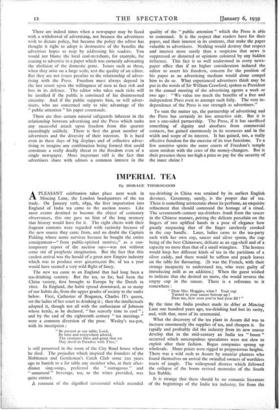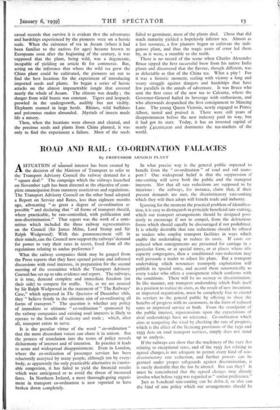IMPERIAL TEA
By HORACE THOROGOOD
APLEASANT celebration takes place next week in Mincing Lane, the London headquarters of the tea trade. On January moth, 1839, the first importation into England of India tea came to the auction rooms. Like most events destined to become the object of centenary observances, this one gave no hint of the long memory that history would have for it. The eight chests with their fragrant contents were regarded with curiosity because of the new source they came from, and no doubt the Captain Pidding whose name survives because he bought the entire consignment—" from public-spirited motives," as a con- temporary report of the auction says—was not without some stir of prophetic imagination. But the fact that this modest arrival was the herald of a great new Empire industry which was to produce over 400,000,000 lbs. of tea a year would have seemed a very wild flight of fancy.
The new tea came to an England that had long been a tea-drinking country. But the tea, so far, had been the China variety, first brought to Europe by the Dutch in 16to. In England, the habit spread downward, as so many of our habits do, from the upper grades of society to the ranks below. First, Catherine of Braganza, Charles II's queen, set the ladies of her court to drinking it ; then the intellectuals adopted it, though not all with the enthusiasm of Johnson whose kettle, as he declared, " has scarcely time to cool " ; and by the end of the eighteenth. century " tea meetings " were a common diversion of the poor. Wesley's tea-pot, with its inscription :
" Be present at our table, Lord, Be here and everywhere adored, Thy creatures bless and grant that we May dwell in Paradise with Thee,"
is still preserved in the room of the City Road house where he died. The prejudice which inspired the founders of the Noblemen and Gentlemen's Catch Club some 200 years ago to banish to a far table any member who, at their after- dinner sing-songs, preferred the " outrageous " and " unnatural " beverage, tea, to the wines provided, was quite extinct.
A remnant of the dignified ceremonial which attended tea-drinking in China was retained by its earliest English devotees. Ceremony, surely, is the proper due of tea. There is something aristocratic about its perfume, an exquisite refinement that should command the homage of a ritual. The seventeenth-century tea-drinkers drank from the saucer in the Chinese manner, poising the delicate porcelain on the fingers of two uplifted hands in a pose of elegance how greatly surpassing that of the finger carelessly crooked in the cup handle. Later, ladies came to the tea-party each with her own cup, saucer and silver spoon, the cup being of the best Chinaware, delicate as an egg-shell and of a capacity no more than that of a small wineglass. The hostess would keep her different kinds of tea in the partitions of a silver caddy, and there would be saffron and peach leaves on the table for flavouring. (It was the French, with their strange incapacity to understand tea, who were guilty of introducing milk as an addition.) When the guest wished to indicate that she desired no more, she would reverse the empty cup in the saucer. There is a reference to it somewhere :
" Dear Mrs. Hoggins, what ? Your cup Turned in your saucer bottom up I Dear me, how soon you've had your fill ! "
By the time the India product made its debut at Mincing Lane one hundred years ago, tea-drinking had lost its rarity, and, with that, most of its ceremonial.
What the discovery of the tea plant in Assam did was to increase enormously the supplies of tea, and cheapen it. So rapidly and profitably did the industry from its new source develop that in the mid-century an India tea " boom " occurred which unscrupulous speculators were not slow to exploit after their fashion. Bogus companies sprang up wholesale. Share prices were rigged to preposterous heights. There was a wild rush to Assam by amateur planters who found themselves on arrival the swindled owners of worthless tracts of jungle. The widespread distress which followed the collapse of the boom revived memories of the South Sea Bubble.
It is strange that there should be no romantic literature of the beginnings of the India tea industry, for from tht casual records that survive it is evident tint the adventures and hardships experienced by the pioneers were on a heroic scale. When the existence of tea in Assam (where it had beeti familiar to the natives for ages) became known to Europeans soon after the beginning of the century, it was supposed that the plant, being wild, was a degenerate, incapable of yielding an article fit for commerce. But, acting on the inference that where the wild tea grew the China plant could be cultivated, the pioneers set out to find the best locations for the experiment of introducing imported seeds and plants. So began a series of heroic attacks on the almost impenetrable jungle that covered nearly the whole of Assam. The climate was deadly ; the danger from wild beasts was constant. Tigers and leopards prowled in the undergrowth, audibly but not visibly. Elephants roamed in large .herds. Rhinos, wild buffaloes and poisonous snakes abounded. Myriads of insects made • life a misery.
Then, when the locations were chosen and cleared, and the precious seeds and plants from China planted, it was only to find the experiment a failure. Most of the seeds failed to germinate, most of the plants died. Those that did reach maturity yielded a hopelessly inferior tea. Almost as a last resource, a few planters began to cultivate the indi- genous plant, and thus the tragic years of error led them by, as it were, a stumble to the truth. • There is no record of the scene when Charles Alexander Bruce sipped the first successful brew from his native India plants and discovered that the flavour, though different, was as delectable as that of the China tea. What a pity ! For it was a historic moment, sealing with victory a long and weary struggle against dangers and hardships that have few parallels in the annals of adventure. It was Bruce who sent the first cases of the new tea to Calcutta, where the Governor-General hailed its beverage with enthusiasm, and who afterwards despatched the first consignment to Mincing Lane. The young Queen Victoria, newly engaged to Prince Albert, tasted and praised it. There were still years of disappointment before the new industry paid its way, but it had got its start. Today, it has an invested capital of nearly L40,000,000 and dominates the tea-markets of the world.











































 Previous page
Previous page